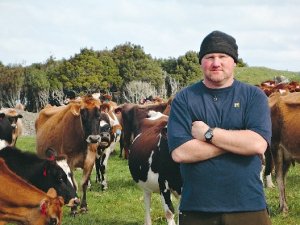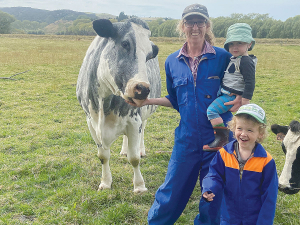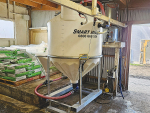They farm at Te Kiri, 7km from Opunake, and are into their fifth year of farm ownership. They are “10 minutes from the sea and 10 minutes from the mountain,” on flat-to-rolling country with plenty of stones – some “rather large.”
The home farm is 130ha with an 83ha run-off 5km away. It runs the young calves from weaning and the whole herd when they are dry. They are walked back to the farm when they are close to calving.
“Our herd of 300 cows is a fruit salad: predominantly Jersey, with some Ayrshires, Friesians, Milking Shorthorns and even 12 Friesian, Angus and Hereford cross-bred cows,” says Clough. They are milked through a 23-aside herringbone dairy shed.
The home farm is being re-fenced to give more even size to the paddocks. As part of the development they plant 4.6ha of turnips and last year as an experiment 6ha of an annual grass. They use fine particle application fertiliser, ground spread on the home property and aerially on the run-off.
They themselves harvest 500 round bales of hay and haylage. Ninety tonnes of PKE is fed in the spring in portable troughs and mineral based licks are also available. Minerals are also supplied through a dispenser during the spring.
“We have always supplied molasses to our milkers through an in-shed dispensing system where they get a measured amount through 23 nozzles.”
At the start of this season they added Palamountains Revive to this dispensing system and immediately noticed an improvement with their stock. It contains omega 3, 5 and 6, multivitamins, electrolytes, biotins, antioxidant and is calcium and magnesium enriched. It can be fed through a dispenser or added in a liquid form to supplementary feeds such as hay and silage
It was only fed to the calved cows from August until December.
“After adding it, the cow’s condition was improving within two weeks of calving and I had cows – even the younger ones – cycling after 3-4 weeks from calving and there was a lift in milk volumes.”
Clough says the droppings were a lot firmer instead of the usual looseness seen in the spring; to him that meant they were a lot healthier.








